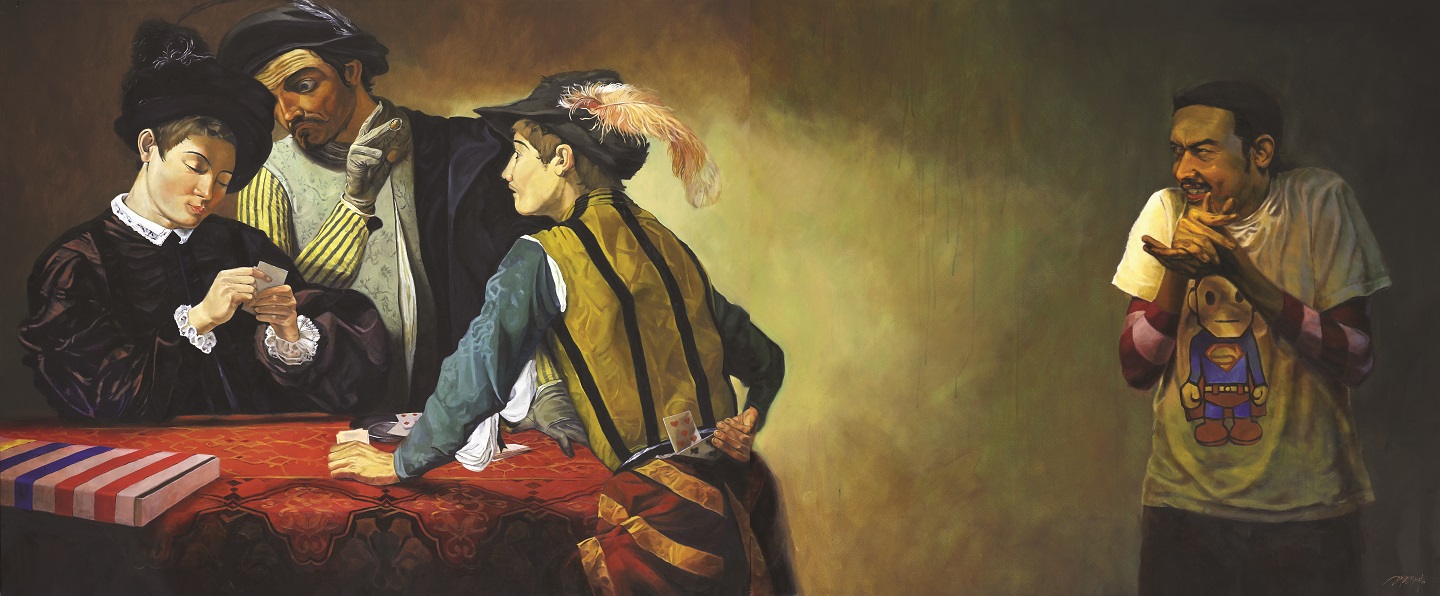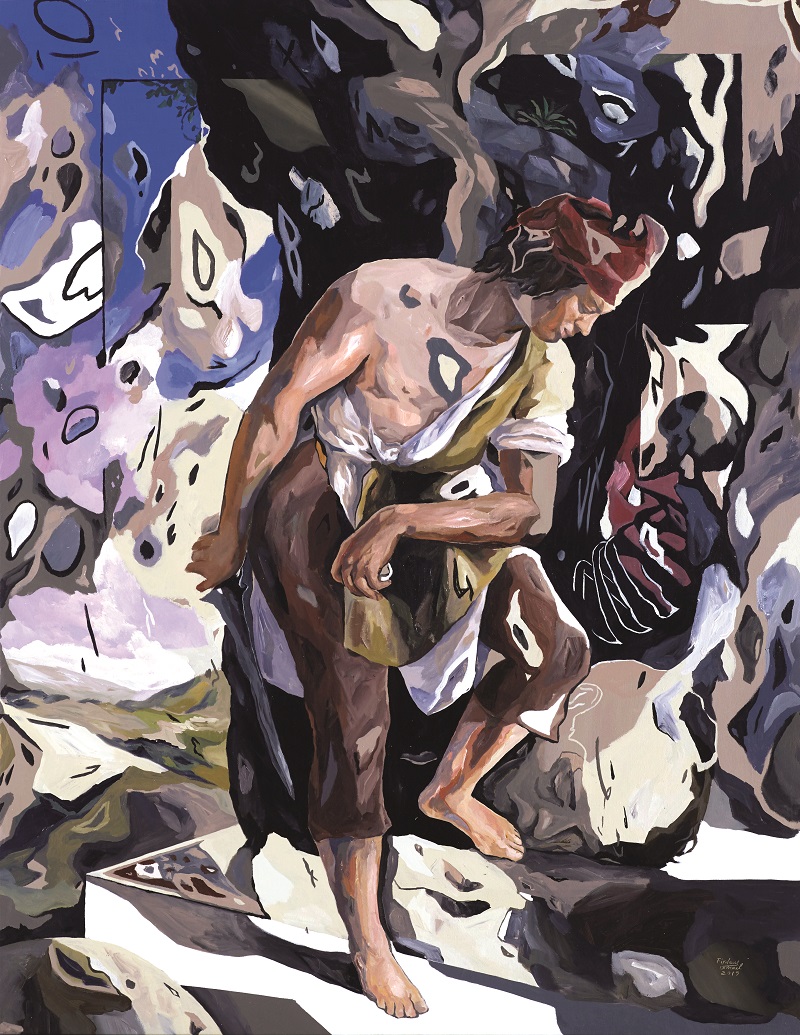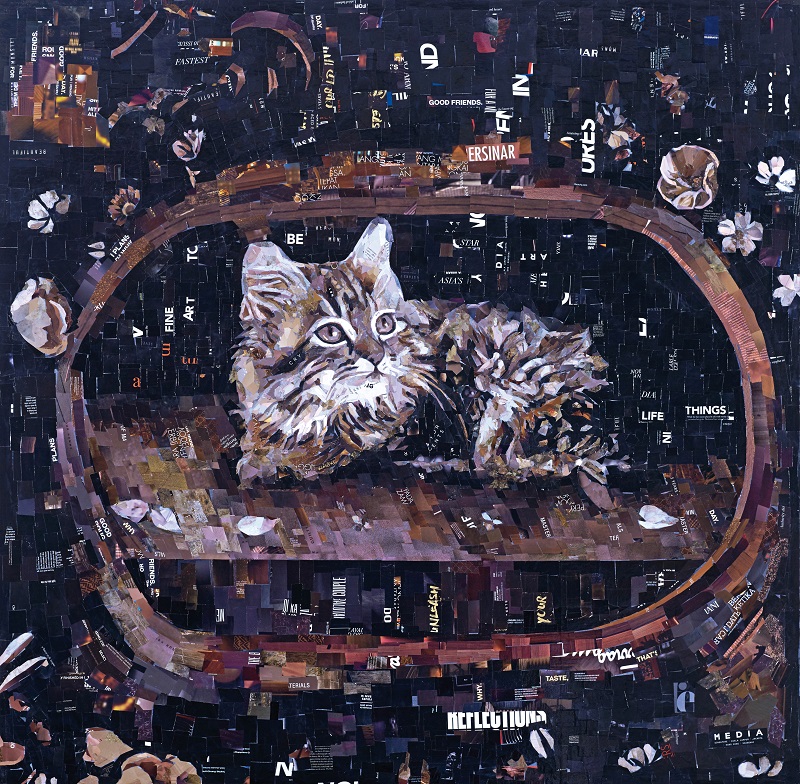
Ali Nurazmal Yusoff's Imitation Master After Caravaggio (All Photos: Core Design Gallery)
In 2009, Malaysian painter Ali Nurazmal Yusoff created a work titled Imitation Master After Caravaggio, which, as indicated, was an imitation of the Italian master’s 1594 painting, The Cardsharps. Recreating the original image on the left, Ali Nurazmal then painted himself into the picture in a tongue-in-cheek manner, injecting a sense of contemporary reality, right down to the cartoon motif on his t-shirt.
It would become a seminal work for the artist and the start of a series of such imitations, with each seeing him insert himself into Caravaggio’s works in a much more intertwined manner and more boldly than the one before. That sense of experimentation and revisiting of classical painting techniques — and their effect on his artistic practice since then — particularly captivated Core Design Gallery director Scarlette Lee, who decided to work with 10 Malaysian artists to further explore the idea of creating works based on the Baroque art period. This culminates in Neo Baroque — A Malaysian Reinterpretation, a group exhibition currently being held at Core Design.

“It is not so much the work itself that inspired the exhibition, but the significance of it,” says Lee. “Before the 2009 work, Ali was known for works with naïve and cutesy motifs, interior and perspective works. He told me that some collectors commented that because he could not do figurative work, he would not go far. So he decided to show what he was capable of by creating a masterpiece, and we know he did it in quite a smart way by reproducing an already well-known one and inserting himself into it.”
She observes how leaving his comfort zone transformed Ali’s practice. “There was an obvious shift after he went back to the fundamentals of classical painting, almost like a restart that then launched him back into surrealistic and expressionistic works, such as his current deconstruction art pieces. Similarly, I wanted to encourage younger artists to move out of their comfort zone, with art history in mind.”
While she is personally a big fan of the late Baroque art period, particularly Caravaggio, Rembrandt and Peter Paul Rubens, all of whose works are referenced in the exhibition, Lee says a lack of appreciation of the value of art history and the importance of its study by artists can stunt their growth. It is about creating art with knowledge and not just talent, she says.

“Today, many can claim they are artists. They are no doubt talented, plus technology now allows us to do a lot, but you cannot hide a lack of formal and fundamental training. The perspective, the way the imagery is brought out, the creation of depth and space, that is knowledge. It is about the hows and the whys. And because the classics did them so well, it is worth looking back at as history affects how we look at things now, and from it we can envision how to go forward,” Lee says.
She also picked the Baroque period rather than the Renaissance for its similarities in approach and characteristics to the strokes and techniques that many artists today are taught. Interestingly, with the exception of one self-taught artist, each of the exhibiting artists graduated from Universiti Teknologi Mara.
Featuring 17 works, about two by each artist, Neo Baroque feels somewhat like walking through an institutional gallery or museum, albeit in a bite-size and introductory level. Lee’s curation of the project has seen the artists reference specific classical artworks, reinterpreting them either in technique, idea or both. While some artworks are obviously more mature than others in ideation and execution, the majority of works are compelling to look at, not unlike how one would stand in front of a Rembrandt.

The comprehensive art notes on each piece also offer the background, reasoning and inspiration of the artist, as well as a small image of the original Baroque classic it is based on. Perhaps setting the tone best is Arikwibowo Amril’s Selfie, a charcoal collage self-portrait that mimics Rembrandt’s. In the interspersing strips of drawings, he creates both juxtaposition and meshing of past and present, one that identifies himself with the Dutch master and at the same time as if peeling Rembrandt away. The work is completed with a classical-style gold frame that heightens the focus on the portrait.
Similarly inserting herself into the work is collage artist Anisa Abdullah, who plays on the Baroque characteristic of light and shadow with two works — Meraikan (After Velazquez), inspired by Diego Velazquez’s Las Meninas and Si Kelabu (After Josefa de Ayala), which draws from the 17th-century female Portuguese painter’s Easter Lamb. In the latter, she cheekily replaces the Christian sacrificial lamb with a furry cat, her witty rendition masking what is an incredibly detailed and technically challenging work, especially in rendering the brushstrokes of the fur through collage.

Husin Othman’s The Great Men and The Winner of Warriors mark the first time the artist has used oil paint, in an attempt to capture the dramatic quality and rich visuals of Rubens’ works, specifically The Lion Hunt and The Defeat of Sennacherib. His version features mechanical details, such as what seems to be a carousel, and a scramble by men towards the “light”. Still, it reflects what the classics revealed: that mankind is constantly battling with one another and trying to get ahead.
Lee says, overall, the objective of Neo Baroque was achieved, in that each artist pushed their works to a new level. “For example, with Anisa, you have never seen such detailed works before. Khairul Izham’s use of steel wires in figurative painting is the most expressive he has done. Firdaus Ismail is fairly new to the mainstream art scene, even though he has done realist figures for the past eight years. He only got more attention as he started doing deconstructed paintings. I encouraged him to marry both in his interpretation of the biblical tale of David and Goliath, which he did by transforming the figures into Hang Jebat and Hang Tuah.
“While Hirzaq (Harris) is known for his stamp series, he has always depicted objects and created super flat kinds of works. This is the first time he has attempted a realist figure, painting his wife in a reference to Johannes Vermeer’s Girl with a Pearl Earring.” Also exhibiting are Syahmi Jamaluddin, Firdaus Nordin, Aely Manaf and Sabihis Md Pandi.
Core Design Gallery, No. 87, Jalan SS 15/2A, 47500, Subang Jaya. Until Apr 15. Mon-Fri, 11am-7pm; Sat-Sun, 12-6pm by appointment only. See more here.
This article first appeared on Apr 1, 2019 in The Edge Malaysia.


